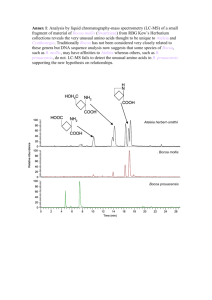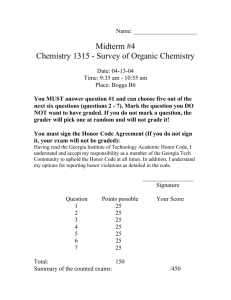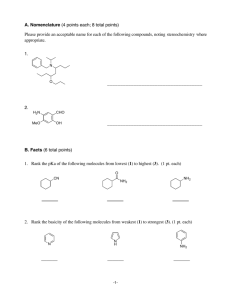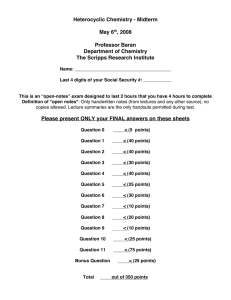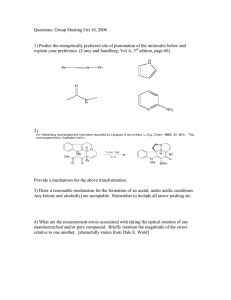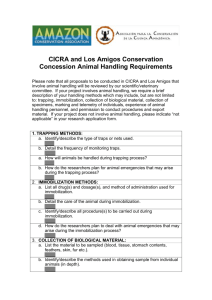Document 13551815
advertisement
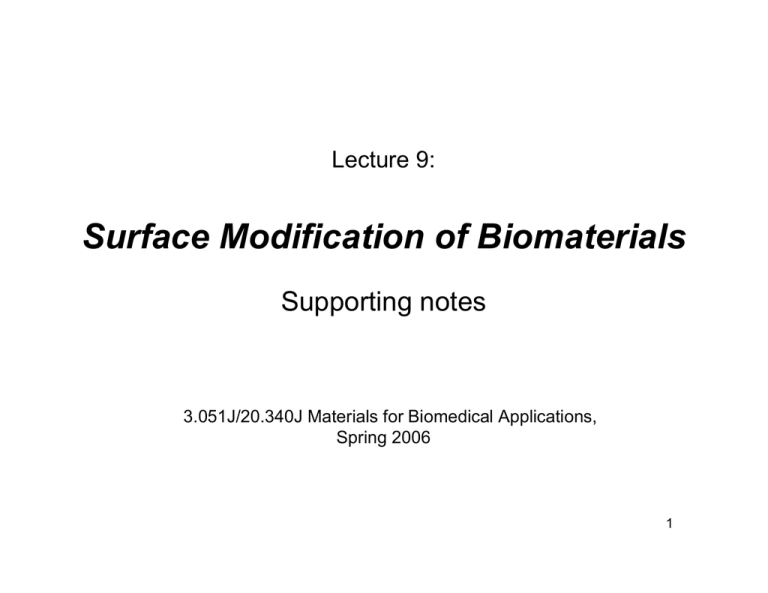
Lecture 9: Surface Modification of Biomaterials Supporting notes 3.051J/20.340J Materials for Biomedical Applications, Spring 2006 1 Purpose: Alter surface properties to enhance performance in biological environment while retaining bulk properties of device The modified zone at the surface of the device should be as thin as possible. Ideally < 1 nm 2 Specific objectives: 1. Clean a surface 2. Reduce/eliminate protein adsorption 3. Reduce/eliminate cell adhesion 4. Reduce bacterial adhesion 5. Reduce thrombogenicity 6. Promote cell attachment/adhesion 7. Alter transport properties 8. Increase lubricity 9. Increase hardness 10. Enhance corrosion/degradation resistance 3 Preparation of non-fouling surfaces to prevent non-specific protein/cell or bacterial adhesion to reduce thrombogenicity Figure by MIT OCW. Surfaces should be hydrophilic or very hydrophobic. 4 Example of “gold standard” Surface modification with PEO derivative. PEO-PPO-PEO, Pluronic Physical adsorption Chemical immobilization Short-time use Ex. Drug delivery Long-time use 5 Other strategies for hydrophilic surfaces 1 Albumin coating surface Phospholipid-mimicking surface N+ N+ N+ N+ Albumin O -O O P O -O O P O -O O O O O P O -O O O O O O O O O P O O Hydrophobic chain Physical adsorption Serum albumin: High water solubility and stability No affinity to proteins and platelets Hydrophilic phosphocholine head Hydrophobic acylchain 6 Other strategies for hydrophilic surfaces 2 Heparinized surface OR O COO­ O OSO3O O OH OH COO- OSO3O O O OH OH OH NHSO3 - OH O O O NHR- Endothelial cell attachment OSO3- NHSO3 - Heparin: Natural blood vessel lining: Immobilized covalently and ionically Inhibitor for thrombin or platelet adhesion Fibrinolytic activity (hydrolysis of fibrin) Plasma treatment Water soluble polymer OH COOH Will be discussed soon 7 NR6 WT fibroblast adhesion triggered by RGD recognition Photos removed for copyright reasons. 500 µm O O N OH Peptide coupling O N RGD O O O PCL-g-PEO PCL-g-PEO+RGD O HN NH2 HN NR6 WT: mice fibroblast bearing human integrin Taniguchi, Polym Int. submitted O H N H2N O N H OH OH O O Arginine Glycine Aspartate R G D 8 Biomolecule immobilization method for specific surfaces Physical adsorption Physical “entrapment” Covalent attachment van der Waals Electrostatic Affinity Adsorbed and cross-linked Barrier system Hydrogel Dispersed system Soluble polymer conjugate Solid surface Hydrogel Biomolecules: proteins/peptides, saccharides, lipids, drugs, ligands, nucleic acids/nucleotides, (cells,) etc. 9 Chemical modification of materials ref. Ratner, Biomaterials Science, p. 229 For covalent binding to an inert solid polymer surface, the surface must first be chemically modified to provide reactive groups for the subsequent immobilization step. -OH -SH -NH2 -CH=CH2 -COOH etc. 10 Protein/peptide immobilization strategies 1 Major reacting groups: -NH2 Activation of -OH O Cl C O O NO2 OH R O C O NO2 O NH2 O C NH R O Cl OH SO2CH2CF3 R O S CH2CF3 NH2 NH R O Cl N Cl Cl N N N OH R N O NH R R NH2 N N O N N R All the procedures must be carried out under anhydrous condition R 11 Protein/peptide immobilization strategies 2 Major reacting groups: -NH2 Activation of -NH2 O N O NH2 O O O O O O O N O R N H O N NH2 N H N H O Activation of -COOH O O HO N O COOH O R C O N NH2 O C H N R H N R O O COOH SOCl2 Be careful! O R C Cl NH2 C 12 R Protein/peptide immobilization strategies 3 Major reacting groups: -COOH Activation of -NH2 H R1 R N C N R2 N+ R1 O COOH R carbodiimide Portein/peptide C O C HN R2 H N+ R1 O R C O C O HN NH2 R2 H N C HN R + O R1 C HN R2 13 Protein/peptide immobilization strategies 4 Chemoselective ligation SH O C Br R HS R S R O C O R O O O HS S R N N O O R C S H2N O O R R R C N O R Reactions take place between selected pairs of functional groups 14 Other chemical surface modifications Preparation of hydrophobic and inert surfaces O Fluorination O OH OH CF2 Cl CF3 OH OH O O CF2 O O CF2 O O CF2 O CF2 CF3 CF3 CF3 CF3 Silanization OH O O Si OH O O Si O Si OH O OH O OH OH O OH OH OH OH O O Si Si OH O O Si O 15 Summary: · Clean a surface · Reduce/eliminate protein/cell/bacteria adsorption, reduce thrombogenicity Non-fouling and bioinert surfaces · Promote biological response Immobilization of biomolecules Short time - Physical adsorption Long time - Covalent bonding 16
